|
|
|
Sort Order |
|
|
|
Items / Page
|
|
|
|
|
|
|
| Srl | Item |
| 1 |
ID:
094283


|
|
|
|
|
| Publication |
2010.
|
| Summary/Abstract |
This paper deals with MARKAL allocations for various energy sources, in India, for Business As Usual (BAU) scenario and for the case of exploitation of energy saving potential in various sectors of economy. In the BAU scenario, the electrical energy requirement will raise up to 5000 bKwh units per year or 752 GW of installed capacity with major consumers being in the industry, domestic and service sectors. This demand can be met by a mix of coal, hydro, nuclear and wind technologies. Other reneawbles i.e. solar and biomass will start contributing from the year 2040 onwards. By full exploitation of energy saving potential, the annual electrical energy demand gets reduced to 3061 bKwh (or 458 GW), a reduction of 38.9%.The green house gas emissions reduce correspondingly. In this scenario, market allocations for coal, gas and large hydro become stagnant after the year 2015.
|
|
|
|
|
|
|
|
|
|
|
|
|
|
|
|
| 2 |
ID:
094249


|
|
|
|
|
| Publication |
2010.
|
| Summary/Abstract |
Climate change has come to the forefront of Australian politics and there is now an active on-going policy debate about how to best reach a commonly agreed long term goal. This paper looks at five major dimensions of this debate and constructs policy options based on them. A discrete choice experiment approach was used with a representative sample from a major internet panel provider. Survey respondents made choices between pairs of policy options with different characteristics. They favored policies starting in 2010 rather than 2012, and spending 20% of revenue raised on energy-related R&D. They were almost evenly split on whether the plan should initially exempt the transport sector and two competing approaches that redistribute revenue from the plan, and, they opposed plans giving special treatment to energy-intensive sectors of the economy. A number of other policy relevant questions related to understanding Australian views and knowledge related to climate change also were asked.
|
|
|
|
|
|
|
|
|
|
|
|
|
|
|
|
| 3 |
ID:
094259
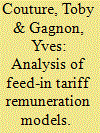

|
|
|
|
|
| Publication |
2010.
|
| Summary/Abstract |
Recent experience from around the world suggests that feed-in tariffs (FITs) are the most effective policy to encourage the rapid and sustained deployment of renewable energy. There are several different ways to structure a FIT policy, each with its own strengths and weaknesses. This paper presents an overview of seven different ways to structure the remuneration of a FIT policy, divided into two broad categories: those in which remuneration is dependent on the electricity price, and those that remain independent from it. This paper examines the advantages and disadvantages of these different FIT models, and concludes with an analysis of these design options, with a focus on their
|
|
|
|
|
|
|
|
|
|
|
|
|
|
|
|
| 4 |
ID:
094395
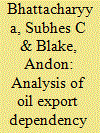

|
|
|
|
|
| Publication |
2010.
|
| Summary/Abstract |
The purpose of this paper is to analyse how oil export dependencies of Middle East and North African (MENA) oil producers have evolved over the past two decades and to identify the main driving factors from an energy policy perspective. The paper expresses the oil export dependency of each economy in terms of a multiplicative identity that captures effective export price, export to primary oil supply ratio, oil dependency and oil export intensity of the country. Using the data for 1980-2006, the evolution in these factors is investigated for seven MENA countries and the influence of the above factors is decomposed using the Laspeyres index. The analysis shows that energy price and increasing energy intensity in the MENA countries have influenced the overall oil export dependency. Reducing the energy intensity can improve oil export revenue share to GDP by 5-10% in most of the countries while Iran can gain significantly by increasing its export volume.
|
|
|
|
|
|
|
|
|
|
|
|
|
|
|
|
| 5 |
ID:
094219


|
|
|
|
|
| Publication |
2010.
|
| Summary/Abstract |
Large appliances are major power consumers in households of industrialized countries. Although their energy efficiency has been increasing substantially in past decades, still additional energy efficiency potentials exist. Energy policy that aims at realizing these potentials faces, however, growing concerns about possible adverse effects on commodity prices. Here, we address these concerns by applying the experience curve approach to analyze long-term price and energy efficiency trends of three wet appliances (washing machines, laundry dryers, and dishwashers) and two cold appliances (refrigerators and freezers). We identify a robust long-term decline in both specific price and specific energy consumption of large appliances. Specific prices of wet appliances decline at learning rates (LR) of 29±8% and thereby much faster than those of cold appliances (LR of 9±4%). Our results demonstrate that technological learning leads to substantial price decline, thus indicating that the introduction of novel and initially expensive energy efficiency technologies does not necessarily imply adverse price effects in the long term. By extending the conventional experience curve approach, we find a steady decline in the specific energy consumption of wet appliances (LR of 20-35%) and cold appliances (LR of 13-17%). Our analysis suggests that energy policy might be able to bend down energy experience curves.
|
|
|
|
|
|
|
|
|
|
|
|
|
|
|
|
| 6 |
ID:
094264


|
|
|
|
|
| Publication |
2010.
|
| Summary/Abstract |
This research assesses to what extent current Dutch energy transition policy instruments for the existing housing stock can fulfil local executive actors' needs and instigate adoption of energy efficiency measures by them. This is done by studying energy policy instruments for the existing housing stock in the Netherlands and in other European countries, and by an empirical research, which analyses barriers and needs of local executive actors. We found that, despite current Dutch energy transition policy instruments for the existing housing stock seem to fulfil local executive actors' needs to a large extent, complementary policy instruments are needed to stimulate and pressure the incumbent renovation regime. A long-term oriented financial rewarding system is needed to build up a structural market for the deployment of renewables, to increase the number of specialist jobs in the building sector, and to stimulate the development of integrated, standardized, building components. Furthermore, a long-term oriented financial rewarding system for energy efficiency investments in housing renovation projects, and a low VAT rate applied to energy efficient renovation measures, are needed. Finally, enforcement possibilities and sanctions (fines) should become an integrative part of Dutch energy certification regulation to make the certificate become part of a value chain
|
|
|
|
|
|
|
|
|
|
|
|
|
|
|
|
| 7 |
ID:
094224


|
|
|
|
|
| Publication |
2010.
|
| Summary/Abstract |
According to the US Energy Information Administration, space and hot water heating represented about 20% of total US energy demand in 2006. Given that most of this demand is met by burning natural gas, propane, and fuel oil, an enormous opportunity exists for directly utilizing indigenous geothermal energy as a cleaner, nearly emissions-free renewable alternative. Although the US is rich in geothermal energy resources, they have been frequently undervalued in America's portfolio of options as a means of offsetting fossil fuel emissions while providing a local, reliable energy source for communities. Currently, there are only 21 operating GDHS in the US with a capacity of about 100 MW thermal. Interviews with current US district heating operators were used to collect data on and analyze the development of these systems. This article presents the current structure of the US regulatory and market environment for GDHS along with a comparative study of district heating in Iceland where geothermal energy is extensively utilized. It goes on to review the barriers and enablers to utilizing geothermal district heating systems (GDHS) in the US for space and hot water heating and provides policy recommendations on how to advance this energy sector in the US.
|
|
|
|
|
|
|
|
|
|
|
|
|
|
|
|
| 8 |
ID:
094405


|
|
|
|
|
| Publication |
2010.
|
| Summary/Abstract |
This article investigates the barriers to energy efficiency at the residential sector within one province in China and explores patterns of household electricity consumption. The article presents the results of a survey questionnaire distributed to more than 600 households in Liaoning Province, field research at various Liaoning government agencies, and research interviews of Liaoning government officials to determine the efficacy of their energy efficiency efforts in China. It then investigates the extent that electricity consumers have taken advantage of energy efficiency opportunities relating to more efficient lights, water heaters, appliances, air-conditioners and heaters, and better energy-efficiency labels. The article also assesses the degree that electricity users have become more aware about electricity prices and their levels of consumption, and touches on the connection between rising levels of income and electricity use. It concludes by providing recommendations for how to improve efforts to promote conservation and reduce electricity load growth in Liaoning Province and beyond.
|
|
|
|
|
|
|
|
|
|
|
|
|
|
|
|
| 9 |
ID:
094244


|
|
|
|
|
| Publication |
2010.
|
| Summary/Abstract |
Decentralized Energy Planning (DEP) is one of the options to meet the rural and small-scale energy needs in a reliable, affordable and environmentally sustainable way. The main aspect of the energy planning at decentralized level would be to prepare an area-based DEP to meet energy needs and development of alternate energy sources at least-cost to the economy and environment. Present work uses goal-programming method in order to analyze the DEP through bottom-up approach. This approach includes planning from the lowest scale of Tumkur district in India. The scale of analysis included village level-Ungra, panchayat level (local council)-Yedavani, block level-Kunigal and district level-Tumkur. The approach adopted was bottom-up (village to district) to allow a detailed description of energy services and the resulting demand for energy forms and supply technologies. Different scenarios are considered at four decentralized scales for the year 2005 and are developed and analyzed for the year 2020. Decentralized bioenergy system for producing biogas and electricity, using local biomass resources, are shown to promote development compared to other renewables. This is because, apart from meeting energy needs, multiple goals could be achieved such as self-reliance, local employment, and land reclamation apart from CO2 emissions reduction.
|
|
|
|
|
|
|
|
|
|
|
|
|
|
|
|
| 10 |
ID:
094406


|
|
|
|
|
| Publication |
2010.
|
| Summary/Abstract |
The hypothesis of this study is that there is a statistical relationship between the cardiovascular disease mortality rate and the intensity of fuel consumption (measured in gallons/square mile) at a particular location. We estimate cross-sectional regressions of the mortality rate due to cardiovascular disease against the intensity of fuel consumption using local data for the entire US, before the US Clean Air Act (CAA) in 1974 and after the most recent policy revisions in 2004. The cardiovascular disease rate improvement estimate suggests that up to 60 cardiovascular disease deaths per 100,000 residents are avoided in the largest urban areas with highest fuel consumption per square mile. In New York City, for instance, the mortality reduction may be worth about $30.3 billion annually. Across the US, the estimated Value of Statistical Life (VSL) benefit is $202.7 billion annually. There are likely three inseparable reasons that contributed importantly to this welfare improvement. First, the CAA regulations banned leaded gasoline, and mandated reduction in specific chemicals and smog components. Second, technologies such as the Catalytic Converter (CC) for the automobile and the low particulate diesel engine were adopted. Third, biofuels have had important roles, making the adoption of clean air technology possible and substituting for high emission fuels.
|
|
|
|
|
|
|
|
|
|
|
|
|
|
|
|
| 11 |
ID:
094251
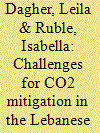

|
|
|
|
|
| Publication |
2010.
|
| Summary/Abstract |
Similar to other developing countries the electricity sector in Lebanon is monopolized by a vertically integrated public utility, Electricite Du Liban (EDL). EDL's supply is characterized by frequent and lengthy power cuts that have given rise to an alternative, informal, and unregulated backup sector, which serves to satisfy electricity demand during the extended blackout periods. This paper examines the evolvement of the backup sector and its related CO2 emissions via the use of scenario analysis. The economic and energy policy implications of each scenario are discussed and a number of policy options are presented to ensure that the growth in CO2 emissions is contained. Results clearly indicate that the backup sector plays a critical role in the success of any greenhouse gas mitigation commitment undertaken by Lebanon. A clear strategy on dealing with this sector needs to be devised simultaneously if not prior to any climate change policy at the national level.
|
|
|
|
|
|
|
|
|
|
|
|
|
|
|
|
| 12 |
ID:
094256


|
|
|
|
|
| Publication |
2010.
|
| Summary/Abstract |
Over the past two decades, China's oil demand has risen steeply. In 1990, it was only about 25% higher than that of 1978, the year economic reform was introduced. By 2008, it had reached 396.0 million tons, roughly four times the 1978 level, making China the second largest oil user worldwide. The country became a net oil importer in 1993, and between 1993 and 2008, its net import dependency-a yardstick for energy security-soared from 7.5% to 50.0%. China's increased demand for oil has made the country a global energy player of critical importance. Although the literature on the global implications of China's oil use has proliferated, relatively few studies have attempted to examine "how China uses oil." Hence, this study covers every oil-consuming facility and sector in China, exploring the patterns of, and factors involved in, oil demand by power plants, oil refineries, heat plants and, gas-works, and industrial, transport, agricultural, household and commercial sectors. It concludes that in virtually all sectors in China, oil demand will grow, with transport and industry leading the way.
|
|
|
|
|
|
|
|
|
|
|
|
|
|
|
|
| 13 |
ID:
094247


|
|
|
|
|
| Publication |
2010.
|
| Summary/Abstract |
Twenty-first century access to energy sources depends on a complex system of global markets, vast cross-border infrastructure networks, a small group of primary energy suppliers, and interdependencies with financial markets and technology. This is the context in which energy security has risen high on the policy agenda of governments around the world and the term 'energy security' has quietly slipped into the energy lexicon. The limited discourse about the nature of the term or its underlying assumptions has been totally eclipsed by an almost overwhelming focus on securing supplies of primary energy sources and geopolitics. An examination of explicit and inferred definitions finds that the concept of energy security is inherently slippery because it is polysemic in nature, capable of holding multiple dimensions and taking on different specificities depending on the country (or continent), timeframe or energy source to which it is applied. This 'slipperiness' poses analytical, prediction and policy difficulties but if explicitly recognised through definitional clarity, new levels of understanding will enrich the policy debate to deal with obstacles impacting on the constantly evolving nature of energy security.
|
|
|
|
|
|
|
|
|
|
|
|
|
|
|
|
| 14 |
ID:
094399
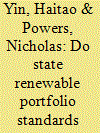

|
|
|
|
|
| Publication |
2010.
|
| Summary/Abstract |
Several US states have passed renewable portfolio standard (RPS) policies in order to encourage investment in renewable energy technologies. Existing research on their effectiveness has either employed a cross-sectional approach or has ignored heterogeneity among RPS policies. In this paper, we introduce a new measure for the stringency of an RPS that explicitly accounts for some RPS design features that may have a significant impact on the strength of an RPS. We also investigate the impacts of renewable portfolio standards on in-state renewable electricity development using panel data and our new measure of RPS stringency, and compare the results with those when alternative measures are used. Using our new measure, the results suggest that RPS policies have had a significant and positive effect on in-state renewable energy development, a finding which is masked when design differences among RPS policies are ignored. We also find that another important design feature - allowing "free trade" of REC's - can significantly weaken the impact of an RPS. These results should prove instructive to policy makers, whether considering the development of a federal-level RPS or the development or redesign of a state-level RPS.
|
|
|
|
|
|
|
|
|
|
|
|
|
|
|
|
| 15 |
ID:
094216
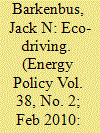

|
|
|
|
|
| Publication |
2010.
|
| Summary/Abstract |
The actions individuals can take to mitigate climate change are, in the aggregate, significant. Mobilizing individuals to respond personally to climate change, therefore, must be a complementary approach to a nation's climate change strategy. One action item overlooked in the United States has been changing driver behavior or style such that eco-driving becomes the norm rather than the exception. Evidence to date indicates that eco-driving can reduce fuel consumption by 10%, on average and over time, thereby reducing CO2 emissions from driving by an equivalent percentage. A sophisticated, multi-dimensional campaign, going well beyond what has been attempted thus far, will be required to achieve such savings on a large scale, however, involving education (especially involving the
|
|
|
|
|
|
|
|
|
|
|
|
|
|
|
|
| 16 |
ID:
094400
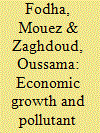

|
|
|
|
|
| Publication |
2010.
|
| Summary/Abstract |
This paper investigates the relationship between economic growth and pollutant emissions for a small and open developing country, Tunisia, during the period 1961-2004. The investigation is made on the basis of the environmental Kuznets curve hypothesis, using time series data and cointegration analysis. Carbon dioxide (CO2) and sulfur dioxide (SO2) are used as the environmental indicators, and GDP as the economic indicator. Our results show that there is a long-run cointegrating relationship between the per capita emissions of two pollutants and the per capita GDP. An inverted U relationship between SO2 emissions and GDP has been found, with income turning point approximately equals to $1200 (constant 2000 prices) or to $3700 (in PPP, constant 2000 prices). However, a monotonically increasing relationship with GDP is found more appropriate for CO2 emissions. Furthermore, the causality results show that the relationship between income and pollution in Tunisia is one of unidirectional causality with income causing environmental changes and not vice versa, both in the short-run and long-run. This implies that an emission reduction policies and more investment in pollution abatement expense will not hurt economic growth. It could be a feasible policy tool for Tunisia to achieve its sustainable growth in the long-run.
|
|
|
|
|
|
|
|
|
|
|
|
|
|
|
|
| 17 |
ID:
094210


|
|
|
|
|
| Publication |
2010.
|
| Summary/Abstract |
Electric power demand forecasts play an essential role in the electric industry, as they provide the basis for making decisions in power system planning and operation. A great variety of mathematical methods have been used for demand forecasting. The development and improvement of appropriate mathematical tools will lead to more accurate demand forecasting techniques.
In order to forecast the monthly electric power demand per hour in Spain for 2 years, this paper presents a comparison between a new forecasting approach considering vector autoregressive (VAR) forecasting models applied to interval time series (ITS) and the iMLP, the multi-layer perceptron model adapted to interval data.
In the proposed comparison, for the VAR approach two models are fitted per every hour, one composed of the centre (mid-point) and radius (half-range), and another one of the lower and upper bounds according to the interval representation assumed by the ITS in the learning set. In the case of the iMLP, only the model composed of the centre and radius is fitted. The other interval representation composed of the lower and upper bounds is obtained from the linear combination of the two.
This novel approach, obtaining two bivariate models each hour, makes possible to establish, for different periods in the day, which interval representation is more accurate. Furthermore, the comparison between two different techniques adapted to interval time series allows us to determine the efficiency of these models in forecasting electric power demand. It is important to note that the iMLP technique has been selected for the comparison, as it has shown its accuracy in forecasting daily electricity price intervals.
This work shows the ITS forecasting methods as a potential tool that will lead to a reduction in risk when making power system planning and operational decisions.
|
|
|
|
|
|
|
|
|
|
|
|
|
|
|
|
| 18 |
ID:
094827


|
|
|
| 19 |
ID:
094223


|
|
|
|
|
| Publication |
2010.
|
| Summary/Abstract |
This paper presents an improved decision model based on the real options approach presented by for the firms that have not yet established energy-saving equipment under the entry and exit strategies. Furthermore, the proposed model takes account of the inevitable equipment renewal and the occurrence of unexpected events under the Poisson jump process. The timing for terminating an investment when continuous operations of that business are unprofitable is also explored to realize the optimal timing of implementing the energy-saving strategy. The future discounted benefit B follows the geometric Brownian motion with the Poisson jump process and the replacement of investment equipment. A numerical analysis is followed by a sensitivity study of various parameters to better realize their impacts on the entry and exit thresholds. The results show that for the jump case, the higher probability of occurrence of unfavorable events will result in a higher entry threshold and lower exit threshold. Investors are forced to request higher benefit thresholds to cover the higher probability of losses brought by unfavorable events.
|
|
|
|
|
|
|
|
|
|
|
|
|
|
|
|
| 20 |
ID:
094284


|
|
|
|
|
| Publication |
2010.
|
| Summary/Abstract |
Following European Directive 2003/30/EC, the Greek Government adapted legislation that introduces and regulates the bio diesel market. The implemented quota scheme allocates the country's annual, predetermined, tax exempt production of bio diesel to industries based on their ability to meet several criteria. A number of bio diesel supply chain stakeholders have criticized this policy for being efficiency-robbing and vague. This paper uses 2007 data from energy crop farms and three bio diesel-producing companies in order to assess these criticisms. We study the economic and environmental aspects of the currently adopted policy and compare them to three alternative scenarios. We conclude that such criticisms have a merit and that policy makers need to reconsider their alternative options regarding the promotion of bio diesel in transport. Permission of sales directly to local consumers and promotion of forward integration by farmers are efficiency enhancing and environment-friendly means of promoting the use of bio diesel in transport.
|
|
|
|
|
|
|
|
|
|
|
|
|
|
|
|
|
|
|
|
|